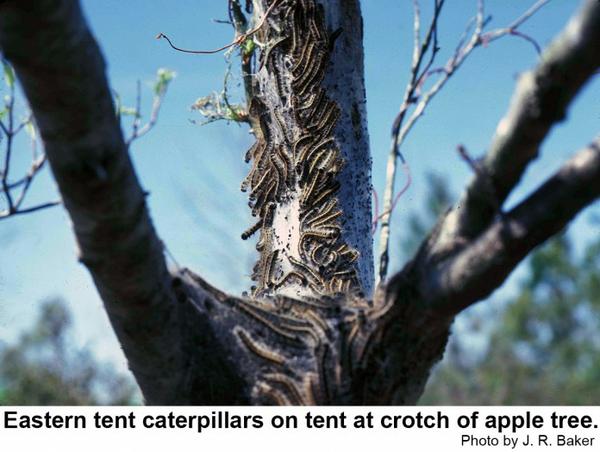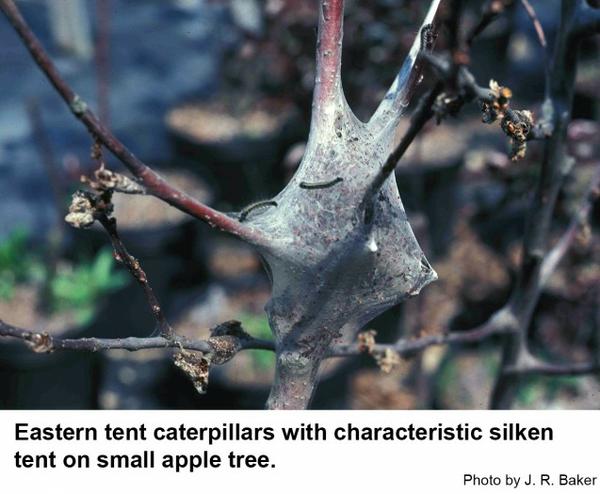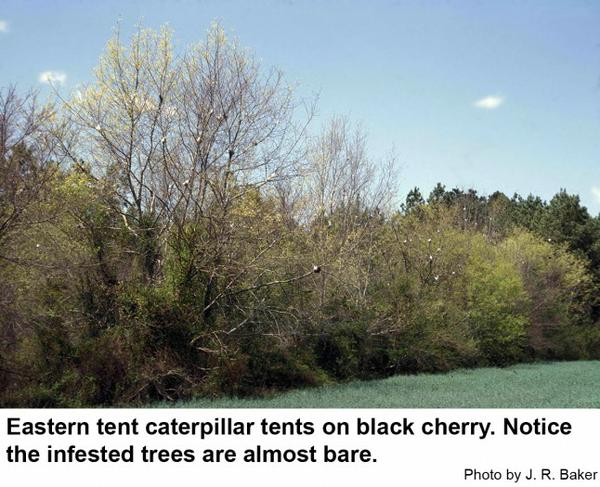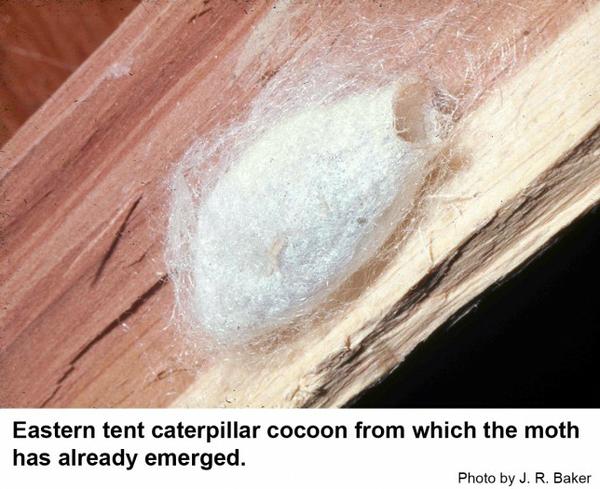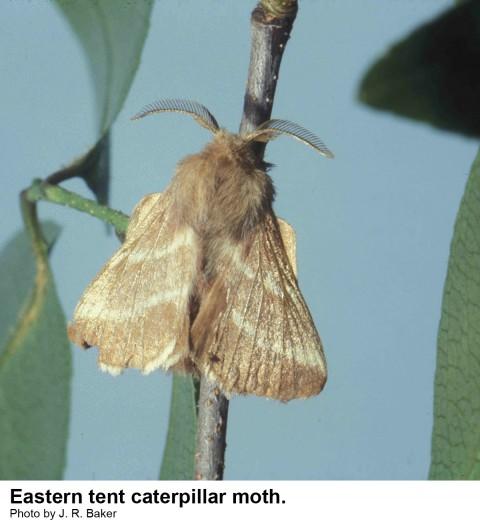General Information
Moths of the eastern tent caterpillar, Malacosoma americanum, are brown to reddish-brown with two pale diagonal lines on the forewing. Eggs are laid in masses around twigs and covered with a foamy secretion that dries into a firm, brown covering. The larvae hatch but do not emerge from the egg mass until the following spring. Eastern tent caterpillars are somewhat hairy and black with gold, white, and blue markings. There is a white stripe down the back. The caterpillars grow to almost 2 inches long. The cocoon is about 1 inch long and is spun of white or yellowish-white silk.
Biology
Eastern tent caterpillars emerge from the egg mass just as the buds are breaking on wild cherry, crabapples and other ornamental plants. There is only one generation per year (the caterpillar that builds nests in trees later in the summer is the fall webworm). Eastern tent caterpillars build their silk nests in the crotches of wild cherry, crabapple, apple and other host plants. Soon the caterpillars crawl down from the trees to search for a place to spin their cocoons and pupate. Sometime in late spring, a new generation of moths emerges to mate and lay eggs for the following year's generation.
Host Plants
Black cherry, crabapple and apple are the usual hosts of the eastern tent caterpillar, but many other kinds of trees are occasionally infested. Because the tiny caterpillars emerge from the egg masses just as the host plant buds break in spring, they may give their host plants the appearance of never sprouting. The leaves are completely eaten away just as they emerge from the buds. Pregnant mares that ingest eastern tent caterpillars may abort, a phenomenon called mare reproductive loss syndrome.
Residential Recommendation
Because eastern tent caterpillars spend the winter inside the egg masses, one effective method of controlling the caterpillars is to remove and destroy the egg masses before the caterpillars hatch. If the caterpillars have already hatched, the tents can be pulled down with a stick and the caterpillars crushed or otherwise destroyed. {Never use fire to destroy eastern tent caterpillars as fire is extremely dangerous. Fire may damage the tree and fire endangers the operator and nearby property.} Sevin and other pesticides are labeled for caterpillar control in the landscape. Because eastern tent caterpillars also infest woodland trees that are never sprayed, this pest has not developed resistance to pesticides.
Other Resources
- Eastern Tent Caterpillar. Anonymous. 2022. Missouri Botanical Garden.
- Eastern Tent Caterpillar. Bessin, R. 2003 (revised). University of Kentucky Cooperative Estension Service ENTFACT-423.
- The mare reproductive loss syndrome and the eastern tent caterpillar: a toxicokinetic/statistical analysis with clinical, epidemiologic, and mechanistic implications. Sebastian, M. et al. 2003. Veterinary Therapeutics 4 (4): 324-39.
- NC State Extension Plant Pathology Publications and Factsheets
- NC State Horticultural Science Publications
- North Carolina Agricultural Chemicals Manual
For assistance with a specific problem, contact your local N.C. Cooperative Extension center.
Publication date: April 30, 2013
Reviewed/Revised: April 13, 2023
Recommendations for the use of agricultural chemicals are included in this publication as a convenience to the reader. The use of brand names and any mention or listing of commercial products or services in this publication does not imply endorsement by NC State University or N.C. A&T State University nor discrimination against similar products or services not mentioned. Individuals who use agricultural chemicals are responsible for ensuring that the intended use complies with current regulations and conforms to the product label. Be sure to obtain current information about usage regulations and examine a current product label before applying any chemical. For assistance, contact your local N.C. Cooperative Extension county center.
N.C. Cooperative Extension prohibits discrimination and harassment regardless of age, color, disability, family and marital status, gender identity, national origin, political beliefs, race, religion, sex (including pregnancy), sexual orientation and veteran status.



